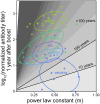This is a preprint.
Quantifying the waning of humoral immunity
- PMID: 40463524
- PMCID: PMC12132162
- DOI: 10.1101/2025.05.13.25327542
Quantifying the waning of humoral immunity
Abstract
Immunological memory is a defining feature of immunity, yet surprisingly there is no consensus on how to quantitatively describe how antibody titers wane over time. A major problem is that the slow waning of antibody titers requires the collection of data for decades post-infection or vaccination. Our analysis of the largest existing dataset shows that a power-law model describes antibody waning better than other frequently used models. Our analysis suggests: (i) Protective levels of antibodies to many vaccine/virus antigens may be maintained for longer than previously estimated. (ii) The rate of waning of antibodies to protein toxoid vaccines such as tetanus may be similar to those elicited by live virus infections. (iii) The long-term waning of antibodies can be estimated from data for a much shorter time-frame of about 1-3 years following immunization, suggesting that using a power-law analysis could allow rapid estimation for the waning of immunity to new vaccines.
Conflict of interest statement
Declaration of Interests The authors declare no competing interests.
Figures






References
-
- Thucydides T. b. C. R. The Peloponnesian war (Digital Library Project. 2004 Tufts University. ¡http://www.perseus.tufts.edu¿., London, Dent J. M., 1910).
-
- Panum P. Lagttagelser, anstillede under maeslinge-epidemien paa faeroerne i aaret 1846 (observations made during the epidemic of measles on the faroe islands in the year 1846). Archiv fur pathologische Anatomie und Physiologie und fur klinische Medizin 1, 492–512 (1847).
-
- Ahmed R. & Gray D. Immunological memory and protective immunity: understanding their relation. Science 272, 54–60 (1996). - PubMed
-
- Burnet F. The clonal selection theory of acquired immunity (University press, Cambridge, 1959).
-
- Murphy K. M., Weaver C. & Berg L. Janeway’s Immunobiology, 10th edition (Norton, 2022).
Publication types
Grants and funding
LinkOut - more resources
Full Text Sources
